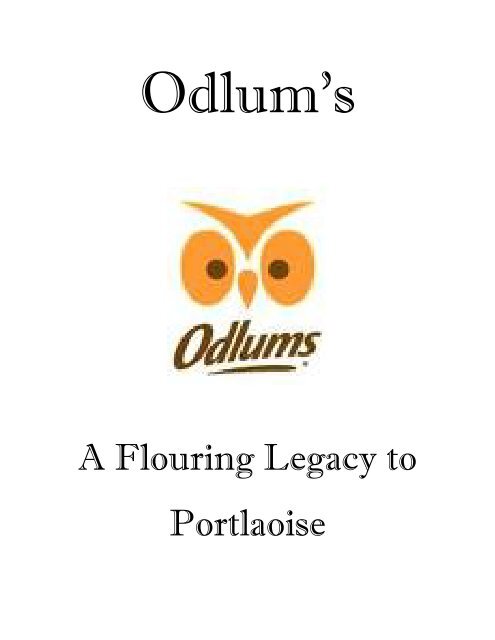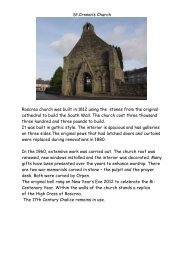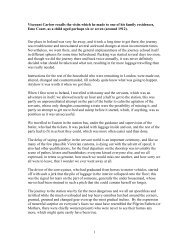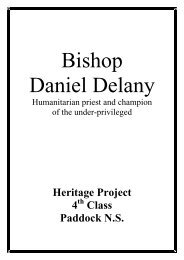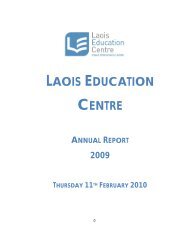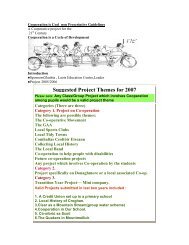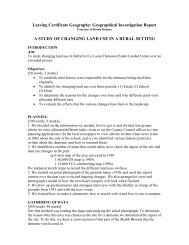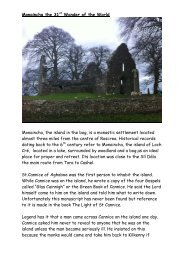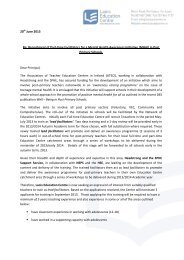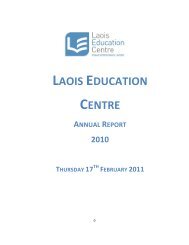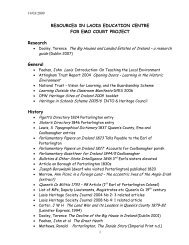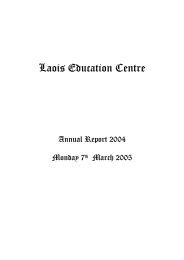William Odlum - Laois education Centre
William Odlum - Laois education Centre
William Odlum - Laois education Centre
You also want an ePaper? Increase the reach of your titles
YUMPU automatically turns print PDFs into web optimized ePapers that Google loves.
<strong>Odlum</strong>’sA Flouring Legacy toPortlaoise
<strong>Odlum</strong>s has been milling and packing flour in the Republic of Ireland forover 160 years.<strong>Odlum</strong>s have over 120 different products.<strong>Odlum</strong>s produces premium flour products in Ireland for traditional homebakers, novice cooks, bakeries large and small, and retailers nationwide.The business was originally established by the <strong>Odlum</strong> family in 1845 whenthey opened their first mill in Portlaoise.This formed the basis for the present business which today operates 2 flourmills in Dublin and Portarlington.This allows <strong>Odlum</strong>s to mill over 120,000 tonnes of flour annually and packover 2.1 million cases.Product innovation is a key component of <strong>Odlum</strong>s business today.The brand continues to offer Irish consumers an extensive range of the bestquality flours and mixes.Our consumer driven approach to business means that each new producthas been created by paying close attention to the needs of its consumers.This approach has allowed <strong>Odlum</strong>s to famous Owl logo create innovativeproducts such as the <strong>Odlum</strong>s Quick Range of cake, scone and bread mixeswhich can be prepared in just 3 simple steps.With a test bakery, R&D team and master bakers, <strong>Odlum</strong>s also works closelywith bakeries of all sizes and produces an extensive range of bulk and baggedflour for the Irish and UK markets.This innovative approach means that <strong>Odlum</strong>s continues to be the brand ofchoice for bakeries throughout the country.<strong>Odlum</strong>s has been an integral part of Irish baking and cooking for generations.Consumers instantly recognise the brand's distinctive cream packaging andit’s famous owl logo.As a core ingredient in baking, the brand's cream plain flour and selfraising flour are sure to be found in kitchen cupboardsthroughout the country. Catherine Leyden, <strong>Odlum</strong>s resident Home Baking expert, hasbeen providing consumers across the country with simple,easy to follow recipes for over 30 years and has helped tomake home baking a fun and enjoyable task for all ages.
<strong>William</strong> <strong>Odlum</strong> (1817-1881)Luck played an important part in this branchof <strong>Odlum</strong>s getting involved in flour milling.If fate hadn’t intervened, the business could haveremained in the hands of the Kelly family and the<strong>Odlum</strong>s brand of today would never hade existed!<strong>William</strong>’s mother was Rebecca Kelly. Her brother,<strong>William</strong> Kelly, operated two mills in Maryborough,Queens – now called Portlaoise.<strong>William</strong> Kelly’s only son died in about 1834. Hedecided to take his nephew, <strong>William</strong> <strong>Odlum</strong> into thebusiness.<strong>William</strong> Kelly died in September 1865 and hiswidow, Ruth Kelly, assigned the buisness to <strong>William</strong><strong>Odlum</strong>. This included the 2 mills at Meelick andMaryborough.<strong>William</strong> expanded 6the business by taking on alease at the green mills in Portlaoise in 1869.
<strong>William</strong> Perry <strong>Odlum</strong> (1843-1922)<strong>William</strong> Perry was sent in 1868 to do his milling training inSamuel Kidd‘s in Isleworth in London-starting a longconnection with England which was to continue insubsequent generations. There he met Emma Podger,daughter of the chairman of the board, <strong>William</strong> Podger, whohe was eventually to marry in 1881.He married in England “years after his father died .Thewedding took place in All Souls Church, LanghamPlace in London 29 th November 1881.“It was distinguished by the fact that all theprincipal actors wept copiously throughout theceremony, the bride and her parents, as was consideredproper and natural, because the latter were losing adaughter, the bridegroom because his father had died onlytwo months before and the clergyman because he wantedMiss Podger as a bride for his own son.’’*They returned to Ireland and lived initially in the Elms inthe town of Portarlington. However, Emma, who had livedin some style in England, aspired to the life of the county set.This saw them move first to Ashfield in Ballybrittas andlater to Huntington, about two miles south of Portarlington.Richard <strong>Odlum</strong> (1845-1924)Richard <strong>Odlum</strong> left school at the age of14.He grew up and married a girl called JaneHinds. Her father was Peter Hinds.Peter was a merchant in the town of Portlaoise.Known as the Guv’nor, Richard was thefinancial and business manager, speculating onwheat futures making a lot of money in theprocess. He had a good brain for decisionmaking but he was an autocratic and two of hissons, Arthur and Harold, rebelled against thisand went to Canada. Harold never returned,dying there in 1962.
.Algernon Claude <strong>Odlum</strong> (1886-1953)Educated in England, first in prep school and later inCharterhouse inSurrey. Algernon worked with his father inPortarlington in 1902, eventually taking over aschairman in 1922.In January 1912, he married Dorothy Chippie Eadieof Bromsgrove, England. The occasion was marred bya fire in the marquee that was to host the reception. Aheavy fall of snow caused the decorations in the tentto come in contact with the stoves witch then ignited,completely destroying the structure. The reception wasthen held in the house and the assembly Rooms inBromsgrove were taken for the ball at night.The couple lived in Kilnacourt, Portarlington whichnow is sadly, burned out shell.Algernon was a successful businessman witha number of company directorship to his creditincluding milling operations as well as beingchairman of the Irish sugar company that eventuallybuy <strong>Odlum</strong>s in 1989.He was president of the IrishFlour Millers Association an 3 occasions1921-22,1939-40 and 1940-41.According to his obituary, he carried outwork for the IrishGovernment on a number of occasions ‘‘and someyears ago.represented the Government at a labour conference inGeneva.<strong>William</strong> Claude (1884-1979)Like his younger brother, Claude educated inCharterhouse school. At the age of 21, he was sent toLeinster mills in Naas which had come into <strong>Odlum</strong>ownership in 1903 on the death of <strong>William</strong>Pemberton. He was later to move into LeinsterGrove, a house which was attached to the mill wherehe was to live for the next 70 years.Claude was the more genial and outgoing ofthe 2 brothers building up connections with the localset. He had a keen interest in horses, owning anumber of racehorses though the years and huntingthe Kildare Hounds, of which he was a member for70 years. He took over the chairmanship of thefamily milling business from Algernon, a post he helduntil years before his death. He was a director on theBank of Ireland from 1929-1966 and acted asGovernor for 2 years. He was also a Director of theGrand Canal Company up to the time of itsdissolution in 1950. He married Doris Barnet inBirmingham Cathedral in 1913-she was from Moseley,Worcester ship which lies south west of Birmingham.
Peter <strong>Odlum</strong> (1915-1983)Peter was the son of Algernon He wasappointed General Manager of the DublinPort Milling company in 1948 at a salary of£1,500 p.a. In 1966 he resigned from this postto devote more time to the affairs ofassociated mills.Peter was president of the Irish FlourMillers Association on four occasions:-1953-4, 1961-2, 1967-8 and 1976-7.Coupled with his business involvement,Peter also had a remarkable sailing careercovering both racing and cruising. He wasCommodore of the Royal Irish Yacht Club inDun Laoghaire.Dick <strong>Odlum</strong> (1922-2002)Dick was one of the last “Privateers” in themotor racing world in a sport that was soon tobe dominated by professional work teams. Dickpurchased a formula 11 Fraser Nash in 1952andparticipated in 2 races in the UK thatyear at Goodwood and Castle Coombe. The carreturned to Ireland at the end of the yearwhere it was to spend the rest of its competingdays. 1953 was a blue riband year with Dickwinning the Sexton Trophy presented by theRoyal Irish Automobile club for the bestperformance by an Irish entrant. Dickparticipated in a variety of races thatincluded a hill climb at Enniskerry, the UlsterTrophy at Dundrod, the Phoenix Park andWakefield Trophy on the curragh where hefinished second in the scratch race. Thefollowing year, 1954, marked the final motorracing event to be held on the curragh withDick coming through on the last lap to win. Healso raced at Dundrod in a car that he sharedwith Cecil Vard.This same partnership came together in 1955 torace in the 23 rd . Le Mans 24hr.race. This timethey drove aSebring Fraser Nash but the caronly lasted 33 laps, the last driven by Dickbefore retitring with mechanical trouble.Ironically this was the same race that theMercedes driven by Pierse Leveigh crashedinto the crowd killing 84Spectators
As we were doing the project we were all wondering why the owl was the symbolused on the packaging of <strong>Odlum</strong> products. Some girls thought that since the owl isseen as ‘’wise’’, the owl symbol was probably a very good logo to use. Imagine oursurprise when we found the <strong>Odlum</strong> crest and not one but four owls incorporatedinto the crest! We felt like real historians.
FamilyResemblances?
1845 The mill that operated in Portlaoise was opened by<strong>William</strong> <strong>Odlum</strong> in 1845. It was this mill thatformed the basis of the present business. He wassucceeded by his two sons <strong>William</strong> Perry andRichard <strong>Odlum</strong>. Hence the name of the companyat that time. W.P&R <strong>Odlum</strong>.1865 <strong>William</strong> Kelly died and both mills –the mill atMeelick and the mill at Church Avenue passed to<strong>William</strong> <strong>Odlum</strong>.<strong>William</strong> <strong>Odlum</strong> leased the Green Mill from <strong>William</strong>Clark, where they ground meal.1874 <strong>William</strong> <strong>Odlum</strong> was succeeded by his two sons<strong>William</strong> P. And Richard (hence the name W.P.and R. <strong>Odlum</strong>) and they went into partnershipwith A.W. Moose and Company, Ballyconar Mills,Ballyragget Co. Kilkenny1876 By 31 st October 1876, they had made a profit of£3,550 but in the next year the partnership lost£315.00 which the auditors, Messer’s. StokesBrothers state, “We think this may occur throughan error in stocktaking”! The partnership was fora term of 10 years from the 1 st September 1874 butit appears to have lasted only for two years.1879 Partnership was established with Henry Pembertonin the Leinster Mills in Naas. This continued until1903 when Mr. Pemberton died and his interestwas taken over completely by the <strong>Odlum</strong> family.1882 The names W.P&R <strong>Odlum</strong> were registered
1898 Business commenced in the mill in St. Mullins.1909 The Mill burned down in 1909 but it wasimmediately rebuilt in 1911.Interestingly, it didnot adopt steam power, but continued to use theTriogue River exclusively until connected to theESB mains in the mid 1900’s. Milling eventuallyceased in 1978 after a new, much larger millcame into operation at Portarlington. The millwas demolished in 1991 and no traces remain.1915 The early years of this century were marked by anexpansion of the business. The Sallins Mills werestarted in December 1915.1920 Many of the mills were built in conjunction withother families who had milling and bakinginterest – the current Dublin site was developed inthe 1920’s with R&H Hall, Kennedy’s and Spices. Bythe end of the 1920’s <strong>Odlum</strong>s were operating atotal of nine mills – Dublin, Cork , Maryborough,Portarlington , Naas, Sallins, Sligo ,Waterford ,and St.Mullins.1935 The silos were erected by a German firm in 1935,jobs in <strong>Odlum</strong>s mill tended to stay within families,passing from generation to generation. Onethinks of the McEvoys.1977 In 1977 the companies name was changed to<strong>Odlum</strong> Group Limited. The company owned andoperated three modern flour mills, an animalfeed mill and an oatmeal mill . Its products aresold nationwide and it employs 250 people. It hasin excess of 50% of the Irish flour market.
The Men Who Built the Mill……Identified (some tentatively) in the photograph are (front row) Johnny Lodge, NewRoad (seated from left), Timmy Duggan, Ballinakill (seated forth from left), andNed Bergin, Grafton Street (standing on right);(second row), <strong>William</strong> Metcalfe,Grattan Street, New Road(big man in white with moustache and cap)and on hisright, John Byrne, New Road, and Chris Farrell, Main Street, and at end of rowJack Grant , Main Street(third row) Cecil O’Carroll, Church Avenue(standingbeside barrier); (back row) Johnny Robinson, Harpurs Lane (fourth from theright), Joe Scully, New Road (seventh from right, smoking pipe )and Andy Doyle,New Road (beside barrier) .
THE MILL HAS STOOD THE TEST OF TIME.Report: SEAMUS DUNNE.The man who built the mill identified in the photograph are Johnny Lodge,New road (seated second from left), Timmy Duggan, Ballinakill (seatedfourth from left),and Ned Bergin, Grattan street(standing on the right);(second row),<strong>William</strong> Metcalfe,Grattan street and New Road (big man inwhite with moustache and cap) and on his right, John Byrne, New Road andChris Farrell, Main Street, and at the end of row ,Jack Grant, Main street;(third row), Cecil O’ Carroll, Church Avenue (standing beside woodenbarrier);(back row), Johnny Robinson,Harpurs lane(fourth from right), JoeScully , New Road(seventh from right smoking pipe) , and Andy Doyle, NewRoad (barrier). Note the number of men in the photograph- buildingcertainly created work in those days. Jack says the cement was mixedand turned with shovels, three men on each side, and he claim’s thateighty tons of cement went into the foundations He adds. There wasno iron in the building. It is mass concrete the whole way”. Sand wasdrawn to the site by horse and cart from Joe Delaney’s of the Ridge, Jackrecalls, and one of carters was Jim Keenan who was also from the Ridge.local man, Bill Carroll may have been the overall contractor, but this isnot certain. As far as is known, Ned Bergin from Grattan street (carQuality Row) was the foreman. What is certain is that the plasteringcontractor was <strong>William</strong> Metcalfe who at that time resided in Grattanstreet. He later moved to New Road. The Metcalfe name was of coursesynonymous with the construction industry in Portlaoise and further afield. The photograph includes tradesmen and general workers –most of themen in the front row are carpenters. They did their job and did it well.These are the men who in 1911 rebuilt <strong>Odlum</strong>’s Mill in Portlaoise, orMaryborough as it was then. It’s an edifice that has stood the test oftime, a monument to their skill, towering over the old town wall. Alas, itsmachinery is now mostly silent, superseded by new technology. It’s the sametoday as the day it was built says Jack Tynan of Grattan Street, Portlaoise.A nonagenarian remembers the construction of the mill. According to him,the old mill was destroyed by fire.
Paddy Hume, Mrs Scott and Bertie Black outside Egans Café andbeside the Watney Stage Coach which journeyed from Dublin toCork in 1963.
Mr. Nigel <strong>Odlum</strong> visited fourth class on the 6 th -12-2010. He told us that when Mr. Kelly died he passedthe bakery on to <strong>William</strong> <strong>Odlum</strong>. That’s how <strong>Odlum</strong>sbusiness began! The first mill in Portlaoise was awater mill. <strong>William</strong> <strong>Odlum</strong> bought the mill around1865, which he turned into a flour mill. The millwas built on church Ave. In 1909 Portlaoise millburned down. In 1911 the mill was rebuilt, with thehelp of the Germans who built the silos. Some of thewheat was ported from Australia, but nowadays88%of the wheat is grown in Ireland. The Silo storedand cared for the wheat. Nigel also told us that<strong>William</strong> <strong>Odlum</strong> had three brothers, who wereMichael, Richard and Michael George. <strong>William</strong> hadthree sons, <strong>William</strong> P, Richard and Michael, butMichael died at an early age. Nigel’s great, great,great, grandfather was <strong>William</strong> <strong>Odlum</strong>s brother,Richard. Nigel was very good to visit us! He gave us<strong>Odlum</strong> bags and a booklet of Christmas recipes!
Mr Nigel <strong>Odlum</strong> visits fourth class
We invited Mr. Teddy Fennelly (<strong>Laois</strong> Heritage) to come tofourth class to tell us about <strong>Odlum</strong>’s, and its importance in thehistory of Portlaoise. He told us that when <strong>Odlum</strong>’s first set upin Portlaoise, the population was approximately 2,000 peopleand the mill finally gave employment to 200 which had a hugeknock- on effect on business in the town. At first, the milldistributed flour locally. There were several bakeries inMountmellick. Horse and cart was the mode of transport andas improvements in transport continued, so too did thedistribution, which expanded to other areas across Ireland.The close proximity of the railway greatly influenced theplaces to which the flour could be sent. Mr. Fennelly gave us abooklet on Portlaoise Heritage, which lists26 places of interestin Portlaoise’s Heritage and he pointed out to us that <strong>Odlum</strong>’sMills is listed as no. 16.Inside is a trail of Portlaoise, The <strong>Odlum</strong>’s mill was a big partof Portlaoise history _it put Portlaoise on the map. <strong>Odlum</strong>s grewinto one of the biggest industries in the country. If a familymember got a job in <strong>Odlum</strong>’s it was considered to be a job forlife, and often times several generations of a family wouldwork at <strong>Odlum</strong>’s.It created great employment for the people of Portlaoise. Wecannot forget it’s importance.By Maria Luttrell & Aimie Ramsbottom
Listening to Mr Teddy Fennelly, <strong>Laois</strong> Heritage Society
GRAINS MILLSGrain mills, for the grinding of cereals into meal and flour,are the earliest and most prevalent type of mills in Ireland.Although mills first appeared in Ireland during the EarlyChristian period (500-1000AD) the vast majority originatedin the 1700s and when cereal growing (particularly oatsand wheat) was at a peak throughout the country. A total of89 grain mills were identified in Co <strong>Laois</strong>, at 88 sites (onesite has two mills; fig 2.1) of the 89 identified mills, 78 werepowered by water!The waterwheel was an early mechanical invention whichwas used as a source of power for mills and for earlyfactories. It was necessary that the mill or factory was builtclose to a fast-flowing stream. ( The Triogue was the sourcefor the Portlaoise mill) The force of the falling water on theblades of the waterwheel caused it to rotate and the powercreated, transmitted to the necessary machines to enablethem to operate. At a mill, waterwheels were oftenconnected to flat mill stones. As the millstones were turned,the corn was ground between them to make flour.
1. The wheat silo: This is a very tall building usedto store the grain. When the grain arrives by roador ship, it is weighed and filled into the silos bymechanical elevators.2. Drying the grain: Moist freshly harvested grainmust be dried in order to prevent mould growth.3. Cleaning: The wheat passes through severalmachines which clean the grain and removeforeign objects. These machines include separators,de-stoners, magnets to remove metal objects andscourers which clean the grain.4. Conditioning: Depending on the moisturecontent of the wheat, moisture may need to beadded or removed from the grain. Stored wheat istoo dry for milling and needs to be conditioned byadding moisture in order to make it suitable forthe rollers.5. Blending: Different types of wheat are combinedto give the required mixture (known as a“grist”) formilling.The milling process now beginsThis involves passing the grain through a series ofrollers and sieves until the germ and bran areseparated.
As we searched the map of Portlaoise.Today we have learnedthat Seval estates have the word “mill” like Mill Court, MillLane, Green Mill Lane, Mill View, Mill Brook, and Mill Street.<strong>Odlum</strong>s has been milling and packing flour in republic ofIreland for over 160 years. With over 120 different productspremium flour products in Ireland for traditional home bakers,novice, cooks, bakeries large and small, and retailers nationswide. The business was originally established by the <strong>Odlum</strong>family in 1845 when the opened there first mill in Portlaoise.This formed the basis for the present business which todayoperates two flour mills in Dublin and Portarlington. Thisallows <strong>Odlum</strong>s to mill over 120,000 tonnes of flour annuallyand pack over 2.1 million cases. Products innovation is a keycomponent of <strong>Odlum</strong>s business today and the brandcontinues to offer Irish consumer an extensive range of thebest quality flours and mixes.The consumer driven approach to business means that eachnew product has been created by paying close attention toneeds of consumers. This approach has allowed <strong>Odlum</strong>s tocreate innovative products such as the <strong>Odlum</strong>s quick range ofcake, scone, bread mixes which can be prepared in just 3simple steps with a test bakery, R, p team and master bakers,<strong>Odlum</strong>s also works closely with bakeries of all sizes andproducts an extensize rang of bulk and bagged flour for theIrish and the U.K markets. This innovative approach meansthat <strong>Odlum</strong>s continues to be the brand of choice for bakery’sthrough the counties.On Wednesday we had a “Baking Day”, where we used someof the <strong>Odlum</strong> products. We had great fun baking!
We enjoyed baking with <strong>Odlum</strong> Products
We enjoyed baking with <strong>Odlum</strong> Products
We enjoyed baking with <strong>Odlum</strong> Products
We enjoyed baking with <strong>Odlum</strong> Products
We enjoyed baking with <strong>Odlum</strong> Products
We enjoyed baking with <strong>Odlum</strong> Products
We enjoyed baking with <strong>Odlum</strong> Products
AcknowledgementsWe would like to thank the following people for helping us with ourproject on <strong>Odlum</strong>s:Mr. Teddy Fennelly from the Heritage Programme in Portlaoise.Mrs. Ann Whelan, our class teacher.Mr. Nigel <strong>Odlum</strong>.Marguerite Gibson, <strong>Laois</strong> County LibraryMr Michael Kavanagh, <strong>Odlum</strong>s, PortarlingtonMs. Ryan (Computer teacher)Ms. O’Loughlin(class teacher)Anne KellyBrendan(the school caretaker)Steven Green ( Nicole’s brother-in-law who built the waterwheel)The girls in fourth class involved in this project were:Niamh Cassidy Kumba Fayiah Jessica GuideraDahna Dwane Wiktoria Rybczynska Nicole McGinleyKatie Dwyer Sophie Caprani Sarah McNeilLauren Hui Maria Carroll Ariane DamianEhlana Hussey Aimie Ramsbottom Lauren AdamsAimee Keane Ellen Langford Holland Tope RajitolaMaria Luttrell Éadaoin Keyes Niamh McEvoyChloe Mc Donagh Marguerite Nevin Jessica O’ConnorJade McEvoy Emer Healy Megan FarrellAimee Mc Donald Megan StylesMollie O’Connor Pratiba SabkotaFiona RaggettEileen Mc Donagh


